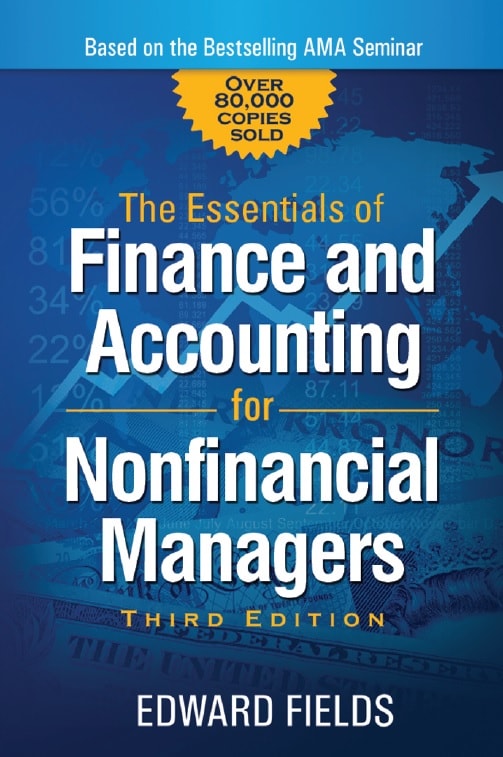The Essentials of Finance and Accounting for Nonfinancial Managers, Third Edition

Contents:
Introduction 1
Organization of the Book 3
Additional Background 9
Accounting Defined 10
Generally Accepted Accounting Principles 11
Financial Analysis 12
Some Additional Perspectives on the Planning Process 14
Part 1: Understanding Financial Information
1. The Balance Sheet 21
Expenses and Expenditures 23
Assets 25
Important Accounting Concepts Affecting the Balance Sheet 33
Liabilities 39
Stockholders’ Equity 41
Total Liabilities and Stockholders’ Equity 43
Additional Balance Sheet Information 44
Analysis of the Balance Sheet 47
A Point to Ponder 58
2. The Income Statement 60
Analysis of the Income Statement 65
3. The Statement of Cash Flows 70
Sources of Funds 71
Uses of Funds 74
Statement of Cash Flows 77
Analyzing the Statement of Cash Flows 78
4. Generally Accepted Accounting Principles: A Review and Update 82
The Fiscal Period 83
The Going Concern Concept 83
Historical Monetary Unit 83
Conservatism 84
Quantifiable Items or Transactions 85
Consistency 85
Full Disclosure 85
Materiality 86
Significant Accounting Issues 86
5. The Annual Report and Other Sources of Incredibly Valuable
Information 91
The Annual Report 92
The Gilbert Brothers: The Original Shareholder Activists 108
Modern-Day Activists 112
The 10-K Report 113
The Proxy Statement 115
Other Sources of Information 116
The Securities and Exchange Commission 118
Part 2: Analysis of Financial Statements
6. Key Financial Ratios 123
Statistical Indicators 123
Financial Ratios 124
Liquidity Ratios 126
Ratios of Working Capital Management 130
Measures of Profitability 139
Financial Leverage Ratios 147
Revenue per Employee 153
Ratios: Quick and Dirty 155
7. Using Return on Assets to Measure Profit Centers 157
Assets 159
Revenue 161
After-Tax Cash Flow (ATCF) 161
Return on Assets: Its Components 162
A Business with No ‘‘Assets’’ 168
8. Overhead Allocations 170
Problems That Arise from Cost Allocation 170
What About the IRS and GAAP? 173
Effect on Profits of Different Cost Allocation Issues 173
Part 3: Decision Making for Improved Profitability
9. Analysis of Business Profitability 185
Chart of Accounts 187
Breakeven Calculation 191
Variance Analysis 203
10. Return on Investment 210
What Is Analyzed? 210
Why Are These Opportunities Analyzed So Extensively? 211
Discounted Cash Flow 213
Present Value 216
Discounted Cash Flow Measures 220
Risk 223
Capital Expenditure Defined 225
The Cash Flow Forecast 226
Characteristics of a Quality Forecast 226
Establishing the ROI Target 230
Analytical Simulations 233
Part 4: Additional Financial Information
11. Financing the Business 239
Debt 240
Equity 249
Some Guidance on Borrowing Money 251
12. Business Planning and the Budget 256
S.W.O.T. Analysis 257
Planning 258
Significant Planning Guidelines and Policies 261
Some Additional Issues 263
A Guide to Better Budgets 264
Preparation of the Budget 266
13. Final Thoughts 269
Profitability During Tough Times 270
Do the Right Thing 273
Appendix A. Financial Statement Practice 279
Appendix B. Finance and Accounting Terms 285
Appendix C. Comprehensive Case Study: Paley Products, Inc. 292
Appendix D. Ratio Matching Challenge 302
Appendix E. Comprehensive Case Study: Woodbridge
Manufacturing 308
Appendix F. Comprehensive Case Study: Bensonhurst Brewery 314
Glossary 319
Index 339
About the Author 345
Free Sample from The First-Time Manager by Loren B. Belker, Jim
McCormick, and Gary S. Topchik 346
Introduction:
This is a book for business people. All decisions in a business organization are made in accordance with how they will affect the organization’s financial performance and future financial health. Whether your background is in marketing, manufacturing, distribution, research and development, or the current technologies, you need financial knowledge and skills if you are to really understand your company’s decision-making, financial, and overall management processes. The budget is essentially a financial process of prioritizing the benefits resulting from business opportunities and the investments required to implement those opportunities. An improved knowledge of these financial processes and the financial executives who are responsible for them will improve your ability to be an intelligent and effective participant.
The American economy has experienced incredible turmoil in the years since this book was first published. Before U.S. government intervention in 2008/2009, we were on the verge of our second ‘‘great depression.’’ We witnessed the demise of three great financial firms, Bear Stearns, Lehman Brothers, and AIG. Corporate bankruptcies were rampant, with General Motors, Chrysler, and most of the major airlines filing. The U.S. government lent the banks hundreds of billions of dollars to save the financial system, while approximately seven million Americans lost their jobs (and most of these jobs will never exist again; see Chapter 6, ‘‘Key Financial Ratios,’’ for a discussion of employee productivity trends). The cumulative value of real estate in this country declined by 40 percent; combining this with the 50 percent drop in the stock market, millions of Americans lost at least half of their net worth. Accounting scandals caused the downfall of many companies, the demise of some major CPA firms, and jail time for some of the principals involved. (Enron would not have happened had its CPA firm done the audit job properly. Bernard Madoff’s Ponzi scheme could not have been maintained had his CPA firm not been complicit.) More than ever, business and organization managers require a knowledge of finance and accounting as a prerequisite to professional advancement. It is for this reason that the second edition included additional accounting and regulatory compliance information and introduced the stronger analytical skills that are necessary to navigate the global economic turmoil.
The depth of the 2008 recession intensified competitive pressures as companies struggled to survive and regain their financial health and profitability. As important and valuable as financial knowledge was prior to the crisis (and the writing of the second edition of this book), it is even more so now.
